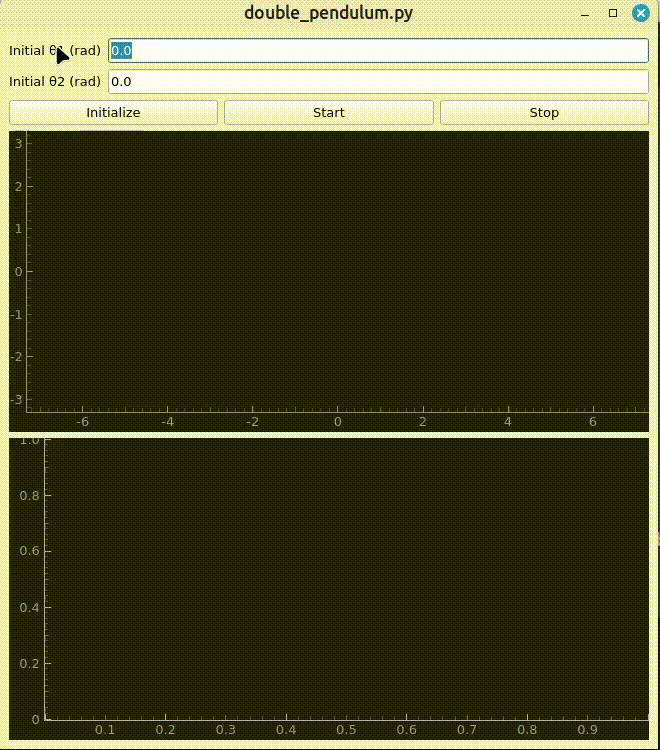The goal of this project is to build a set of composable tools for solving physics problems. There should be a smooth transition between the symbolic problem and the numerical problem.
import sys
import numpy as np
from scipy.integrate import solve_ivp
from python_physics.vizualization.simulation_framework import create_simulation_framework
from PyQt5.QtWidgets import QApplication, QMainWindow, QVBoxLayout, QHBoxLayout, QFormLayout, QLineEdit, QPushButton, QLabel, QWidget
from PyQt5.QtCore import QTimer
def double_pendulum_ode(t, state, l1, l2, m1, m2, g):
theta1, theta1_dot, theta2, theta2_dot = state
delta = theta2 - theta1
denom1 = (m1 + m2) * l1 - m2 * l1 * np.cos(delta)**2
denom2 = (l2 / l1) * denom1
theta1_ddot = (
m2 * l1 * theta1_dot**2 * np.sin(delta) * np.cos(delta)
+ m2 * g * np.sin(theta2) * np.cos(delta)
+ m2 * l2 * theta2_dot**2 * np.sin(delta)
- (m1 + m2) * g * np.sin(theta1)
) / denom1
theta2_ddot = (
-m2 * l2 * theta2_dot**2 * np.sin(delta) * np.cos(delta)
+ (m1 + m2) * g * np.sin(theta1) * np.cos(delta)
- (m1 + m2) * l1 * theta1_dot**2 * np.sin(delta)
- (m1 + m2) * g * np.sin(theta2)
) / denom2
return [theta1_dot, theta1_ddot, theta2_dot, theta2_ddot]
def double_pendulum_positions(state, **kwargs):
l1 = kwargs["l1"] # Extract l1
l2 = kwargs["l2"] # Extract l2
theta1, _, theta2, _ = state
x1, y1 = l1 * np.sin(theta1), -l1 * np.cos(theta1)
x2, y2 = x1 + l2 * np.sin(theta2), y1 - l2 * np.cos(theta2)
return [x1, y1, x2, y2]
def create_double_pendulum_simulation():
l1, l2, m1, m2, g = 1.0, 1.0, 1.0, 1.0, 9.81
dt = 0.02
default_state = [np.pi / 4, 0.0, np.pi / 6, 0.0] # Ensure 4 elements
# Define step simulation function
def step_simulation(state, t, l1, l2, m1, m2, g):
# Define the time range for the solver
t_span = [t, t + dt]
print(f"Step simulation state: {state}")
# Use solve_ivp to compute the next state
sol = solve_ivp(
fun=lambda t, y: double_pendulum_ode(t, y, l1, l2, m1, m2, g),
t_span=t_span,
y0=state,
t_eval=[t + dt] # Evaluate at the next time step
)
return sol.y[:, -1] # Return the state at the next time step
return create_simulation_framework(
step_simulation=step_simulation,
transform_positions=double_pendulum_positions,
default_state=default_state,
dt=dt,
params={"l1": l1, "l2": l2, "m1": m1, "m2": m2, "g": g},
animation_range=(-3, 3),
input_labels=["Initial θ1 (rad)", "Initial θ2 (rad)"],
plot_labels=[("θ1(t)", "#56b6c2"), ("θ2(t)", "#e06c75")],
)
if __name__ == "__main__":
app = QApplication(sys.argv) # QApplication must be instantiated first
simulation = create_double_pendulum_simulation()
gui = simulation["gui"]
# Timer for simulation updates
timer = QTimer()
# Connect buttons to their respective actions
gui["buttons"]["initialize"].clicked.connect(
lambda: (print("Initialize clicked"), simulation["initialize"](gui["inputs"]))
)
gui["buttons"]["start"].clicked.connect(
lambda: (print("Start clicked"), simulation["start"](timer))
)
gui["buttons"]["stop"].clicked.connect(
lambda: (print("Stop clicked"), simulation["stop"](timer))
)
# Connect the timer to the simulation runner
timer.timeout.connect(
lambda: simulation["run"](timer, gui["animation_items"], gui["plot_items"])
)
# Create and display the main window
window = QMainWindow()
container = QWidget()
container.setLayout(gui["layout"])
window.setCentralWidget(container)
window.show()
print("GUI is ready. Waiting for user interaction...") # Debug
sys.exit(app.exec_())
